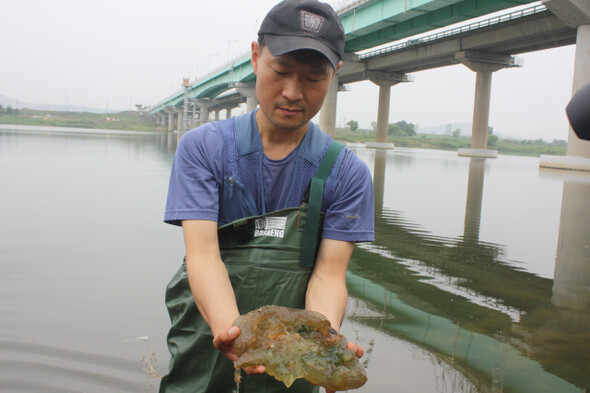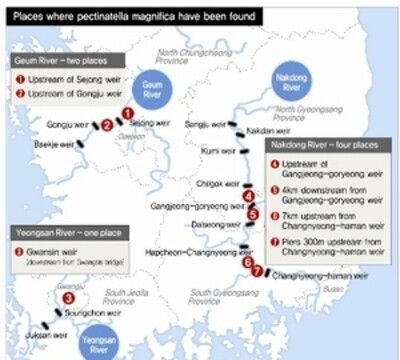hankyoreh
Links to other country sites 다른 나라 사이트 링크
[Special report] Four Major Rivers Project smells like a sewer on the Nakdong

By Choi Sang-won and Kim Il-woo, South and North Gyeongsang correspondents
“Why should river soil smell like a sewer?”
The researchers grimaced as they sniffed the mud samples from the bed of the Nakdong River. It was part of a comprehensive investigation of algae blooms, river structure, ecosystem changes, and facility safety conducted all along the river on July 6 and 7 by the Four Major Rivers Project Investigation Team, a group of environmental professors and civic group members led by Kwandong University professor Park Chang-keun.
The big finding from the investigation was a layer of mud that has formed all along the bed in the two years since construction was finished on eight weirs as part of the Four Major Rivers Project.
“It’s evidence that the waterway is getting blocked as a result of the weirs built for the project, and the Nakdong River is starting to die from the bottom, where you can’t see it,” explained Park.
At 11 am on July 6, Park’s team took a boat upstream from Changnyeong-Haman Weir to measure current speeds and take bed samples. The weir bisects the counties of Changnyeong and Haman in South Gyeongsang Province, along the river’s middle section, and is the furthest downstream of the eight built for the project.
Investigations took place in three locations left, right, and center upstream from the weir. At depths of 1.4 to 2.0 meters, water speeds were just 6 to 14 centimeters per second - as little as one-tenth the ordinary rates of 60 to 70 cm/s for the Nakdong River before the weirs were built.
The sample taken from the riverbed had a layer of mud on top, ranging in thickness from 3 to 10 cm. The mud was black and gave off a rotting, fishy smell, with grains so fine they could be felt with the fingertips, but not held between them.
Similar findings to the Changnyeong-Haman Weir were made by the boat as it traveled further upstream to Hapcheon-Changnyeong weir that afternoon. Current speeds ranged from 2 to 8 cm/s, with the same 3- to 8-cm layer of mud on the bed.
Black mud was also seen on the bed upstream from the Gangjeong-Goryeong Weir in Daegu’s Dalseong County, along the middle section of the Nakdong, when samples were taken on the morning of July 7. This was a few hundred meters away from two major intake facilities: Maegok, which supplies running water to 1.32 million residents of Daegu’s Central, South, West, and Dalseo districts and Dalseong County, and Jukgok (intake facilities), which supplies industrial water to 430 companies in Daegu’s Seongseo Industrial Complex, Bisan Dyeing Industrial Complex, and West Daegu Industrial Complex.
“Before the Four Major Rivers project, mud would only build up each year at the mouth of the Nakdong River in the Gangseo district of Busan, upstream from the Nakdong River estuary weir, which divides the Nakdong River from the ocean. As a result, we spent 1 billion won (US$988,630) a year dredging the river to remove the mud. But now, since mud is piling up upstream from every weir, we have to dredge up mud midstream and upstream on the Nakdong River,” said Park.
“If mud continues to pile up on the riverbed, the organisms that live in the layer of sand below will suffocate and die. Eventually, as eutrophication accelerates, the algae bloom will grow more serious with time. This results from the stagnation of the Nakdong River; as its flow slows and stops, it changes into a lake or swamp. The only way to resolve this problem is to completely open the flood gates of the eight weirs to increase the speed of the water,” Park contended.
“Ordinarily, the bed of rivers such as the Nakdong is composed of bedrock, gravel, and sand in that order starting at the upper region, where the water is flowing rapidly. But the fact that a layer of mud is forming on the bed of the river in its middle and upper regions tell us that the river is stagnating as the water flows slowly because of the Four Major Rivers Project. This means that the Nakdong River is changing from a lotic ecosystem with flowing water to a lentic ecosystem with still water. I’m concerned about water pollution in the future,” said Lee Hyun-jeong, researcher at the Korea Research Institute for Environment and Development.

At the pier of the Korea Water Resources Corporation, or K-water, located 300 meters upstream from the Changnyeong Haman Weir and below the Namji Bridge, 7km further upstream, magnificent bryozoans (scientific name pectinatella magnifica) have been discovered as big as an adult hand. In addition, 10 magnificent bryozoans the size of soccer balls were found 4km downstream from the Gangjeong Goryeong Weir.
Magnificent bryozoans are an invasive species that have been found recently in the Geum River, Yeongsan River, and now in the mid and upper reaches of the Nakdong River. These creatures live in the still waters of reservoirs, for example, and feed on algae blooms. Just like algae blooms, they thrive when the water temperature exceeds 20 degrees Celsius.
Bryozoans begin as spores, 1-2mm in size, floating in the water. When they reach an environment that is appropriate for reproduction, they cling to water plants or other objects. They clump together using their translucent excreta, growing as large as 2m in diameter.
“Magnificent bryozoans do not in and of themselves have a major effect on the aquatic ecosystem, but they are used as an index species to tell whether water is not flowing and is stagnating. The fact that magnificent bryozoans are being discovered not only in reservoirs but also in the main course of the Nakdong River indicates the river has become a suitable environment for the creature to reproduce: the river has stopped flowing and become stagnant, and algal tides are appearing,” said Jeong Min-geol, professor at Kongju National University.

Ships with red clay sprayers were docked at the K-water piers at Changnyeong Haman Weir and Hapcheon Changnyeong Weir. Just as red clay is sprinkled in the ocean when a red tide appears to bring the algae to the bottom of the sea, these ships spray red clay in the river when the algal bloom is severe to lower the algae to the river bed.
“In fact, while spraying large quantities of red clay in the stagnant Nakdong River can decrease the visible algae for the time being, in the end, it accumulates on the riverbed and throws the aquatic ecosystem into turmoil. The government needs to quickly acknowledge the problems with the Four Major Rivers Project and open the water gates of the weirs on the Nakdong River to restore the river’s aquatic ecosystem,” said Lim Hui-ja, policy chief for the Environmental Movement Alliance in Masan, Changwon, and Jinhae.
Please direct questions or comments to [english@hani.co.kr]

Editorial・opinion
![[Guest essay] Amending the Constitution is Yoon’s key to leaving office in public’s good graces [Guest essay] Amending the Constitution is Yoon’s key to leaving office in public’s good graces](https://flexible.img.hani.co.kr/flexible/normal/500/300/imgdb/original/2024/0416/8917132552387962.jpg) [Guest essay] Amending the Constitution is Yoon’s key to leaving office in public’s good graces
[Guest essay] Amending the Constitution is Yoon’s key to leaving office in public’s good graces![[Editorial] 10 years on, lessons of Sewol tragedy must never be forgotten [Editorial] 10 years on, lessons of Sewol tragedy must never be forgotten](https://flexible.img.hani.co.kr/flexible/normal/500/300/imgdb/original/2024/0416/8317132536568958.jpg) [Editorial] 10 years on, lessons of Sewol tragedy must never be forgotten
[Editorial] 10 years on, lessons of Sewol tragedy must never be forgotten- [Column] A death blow to Korea’s prosecutor politics
- [Correspondent’s column] The US and the end of Japanese pacifism
- [Guest essay] How Korea turned its trainee doctors into monsters
- [Guest essay] As someone who helped forge Seoul-Moscow ties, their status today troubles me
- [Editorial] Koreans sent a loud and clear message to Yoon
- [Column] In Korea’s midterm elections, it’s time for accountability
- [Guest essay] At only 26, I’ve seen 4 wars in my home of Gaza
- [Column] Syngman Rhee’s bloody legacy in Jeju
Most viewed articles
- 1[Guest essay] Amending the Constitution is Yoon’s key to leaving office in public’s good graces
- 2Faith in the power of memory: Why these teens carry yellow ribbons for Sewol
- 3[Guest essay] How Korea turned its trainee doctors into monsters
- 4[Editorial] 10 years on, lessons of Sewol tragedy must never be forgotten
- 5Korea ranks among 10 countries going backward on coal power, report shows
- 6Final search of Sewol hull complete, with 5 victims still missing
- 7How Samsung’s promises of cutting-edge tech won US semiconductor grants on par with TSMC
- 8Pres. Park an accomplice in ordering resignation of CJ Group vice chairman
- 9[News analysis] Watershed augmentation of US-Japan alliance to put Korea’s diplomacy to the test
- 10K-pop a major contributor to boom in physical album sales worldwide, says IFPI analyst